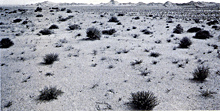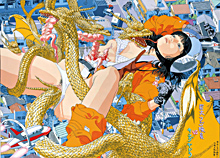6d
東京シミュレーショニズム(2)小沢剛と会田誠
Tokyo Simulationism (2) Tsuyoshi Ozawa and Makoto Aida
【本文確定】
翌1993年は、西原珉が監修したレントゲン藝術研究所の「fo(u)rtunes」展から始まりました。1月15日からのパート1に小沢剛と中野渡尉隆、2月5日からのパート2に会田誠と鳴海暢平を配した参加者4名のグループ展で、小沢剛は「地蔵建立」(ジゾイング)の集大成的な展示にあたり会場にうずたかく布団を積み上げ鑑賞者にその山を登らせ、会田誠は描き溜めていた主要初期絵画群を一挙に出品、初日に布団を一枚だけ敷き自身の絵の前で自慰行為を試みる「虚弱肉体パフォーマンス」を披露しました。
東京原宿にオープンしたマラリアアートショーでは、中村政人と村上隆の共通の誕生日に「中村と村上」2月1日祭が行われ、大人数が殺到しました。このとき小沢剛は中西夏之の「洗濯鋏」を再現し、私は中西の舞台美術「早稲田の赤い便器」を再現しました。このとき私が配布したフライヤで「再現芸術」の言葉が初めて登場し*6d1、「前衛芸術を予告して再現することの台無し感」「再現しようとした途端に原典から遠ざかる」という再現芸術の原理的逆説が顕わにされました。すなわち再現は、過去の前衛を古典化し解毒する過程であるとしたのです。2月27日には同会場で宇治野宗輝の主催になる「デコラティブ」が開催され、村上隆は「ニセ村上隆」を出現させました。そこまでして彼がこだわったのは無意味の徹底だったかもしれません。3月20日、パシフィコ横浜のNiCAF(国際コンテンポラリーアートフェア)会場で、スモールヴィレッジセンターによる小島信明「立像」と小杉武久「楽器」の再現が行われました。4月1日にはギャラリー・アートワッズで私の個展「赤裸々な束子スペシャル」が始まり、会場では日替わりで異なるゲストによる異なるイベントが開催されました。
こうしたある種の無節操さに終止符を打ち、際限ない拡散運動を一挙に束ねて別方向へと流れを変えたのが、中村政人の企画により1993年4月4日から18日まで東京銀座の全域で行われた路上展覧会「ザ・ギンブラート」でした。参加作家は小沢剛、ピーター・ベラーズ、村上隆、岩井成昭、申明銀、西原珉、中村政人、飯田啓子の8名で、各作家自身の責任のもと、美術館や画廊という守られた場ではない路上での発表が要請されました。展覧会名はギンブラ(銀座をブラブラ歩く)とアートの合成語ですが、同展フライヤには「銀座は、繁華街=『消費経済』のイメージと同時に『美術』の中心として貸画廊システム、一週間個展など、独特な日本美術の様式を、その閉鎖性とともにつくりあげてきた場所として有名」とありました。すなわち中村信夫著『少年アート』で日本にアート・ワールドは無いと断じられた元凶が銀座の貸画廊街であるとの認識に立ち、攻勢をかけた図式でした。
初日の日曜日は8名の参加作家と26組のゲストアーティストたちの総勢34組が、オープニング・アクトとして、銀座の歩行者天国の各所でパフォーマンスを繰り広げ、ビジュアル的にもインパクト的にも奇跡的な大成功を収めました。パフォーマンスの傾向はさまざまで、黒山の人だかりを集めた宇治野宗輝の「デコラティブツアー」やパルコキノシタ「辻絵描き」、巡査に連行されそうになった会田誠の「アート・コジキ・イン銀座」や中野渡尉隆「千円で後縁」、コンセプチュアルな飯田啓子の「宅急便」、実際にギンブラしたアロアロフサイ「A Day in Ginza」等、枚挙にいとまがありません。異変に気付いた警察が集結させた白バイ群も、安斎重男がしっかりカメラに収めました*6d2。
そして、なぜかこのたった一日で、それまで村上隆が「無意味」の鍬で耕してきた地平が、中村政人の「有意味」へと塗り替えられたかのようでした。「偶然は無い」と常日頃言っていた中村政人にとって、ギンブラートは「行為の絶対的肯定精神を軸に企画された展覧会」(同展フライヤより)だったのです。そしてこの日を境にトリスタン・ツァラ的で「芸術のための芸術」的な村上隆と、アンドレ・ブルトン的で「人生のための芸術」的な中村政人の決裂が決定的となりました*6d3。
スモールヴィレッジセンターの最後の活動は、ギンブラートで発表された「アンブレラ・プロジェクト」(クリストの同名プロジェクトのパロディ)でした。そして小沢剛の「なすび画廊」が、ギンブラート後の新たな美術シーンとなりました。
なすび画廊は、銀座の老舗の貸画廊「なびす画廊」に対するパロディを意図した小沢剛のギンブラート参加作品で、牛乳箱の内側を白く塗って画廊と称してみせたものでした。つまり中村政人から出された「貸画廊システムへの言及」という一種の宿題に対して、ホワイトキューブを反語的に呈示してみせた優等生的な作品だったのです。しかしオープニング・アクトでの小沢剛は天狗プロジェクト(松橋睦生とのユニット)やスモールヴィレッジセンターの発表に忙しく、彼にとってのなすび画廊は、すでに終わった宿題以上のものではありませんでした。
ところで一方、村上隆は、「銀座の画廊に作品ファイルを持って売り込みに行く」という自虐的な作品「DPE」の実施をギンブラートで事前告知していました。しかしオープニングの当日が、画廊が休業している日曜日だったため、急遽「なんでもない日、万歳」という作品に変更し、その後も「DPE」を実施しようとしなかったため、ついに中村政人の怒りを買いました。
そこで村上隆は、いまや銀座の画廊であるところの「なすび画廊」に売り込みに行きました。その結果、同画廊第1回展として「村上隆大回顧展」が実現することとなり、情報誌にも告知されました。これはおそらく、小沢剛にとっても中村政人にとっても村上隆にとっても、予想外の展開だったことでしょう*6d4。こうしてなすび画廊は、おかしみを交えながら実際の画廊として稼働することとなり、村上隆展以後も、さまざまなアーティストの展覧会がなすび画廊で開催されるようになりました。「東京ポップ」と呼びうる動向は*6d5、引き続き世界一小さなこのポータブルギャラリーに拠点を移し、「なびす画廊」のオーナーに近所から追い払われたり、皇太子ご成婚の折りに撤去させられそうになったり、画廊主である小沢剛の展覧会とともに名古屋や福岡に持って行かれたりしました*6d6。
「fo(u)rtunes」で、すでに完成された傑作絵画群を一堂に展覧した会田誠には、すぐさま次の大きな発表の機会が回ってきたわけではありませんでした。しかし自虐と根暗と幼女趣味的倒錯傾向をにおわせながらも、一作ごとに異なる様式とコンセプトを採用するシミュレーショニスト的な手つき、ならびにそれを可能とする圧倒的な絵画的技量と日本美術史的記憶が、会田誠をして「東京ポップ」のもう一人の重要な立役者へと押し上げていました*6d7。
【第一版ママ】The year 1993 started with the "fo(u)rtune" exhibition of Roentgen Kunst Institut supervised by Nishihara Min. The exhibition was arranged so that Ozawa Tsuyoshi and Nakanowatari Yasutaka performed in the first half of the exhibition period and Aida Makoto and Narumi Nobuhira took the latter half for the Quartet Art Show. Ozawa piled up many futons and made spectators climb up the piles of futons to see his collected works of the "Building Jizo Statues" (Jizo-ing). Aida exhibited the collection of his major early paintings all at once, and he carried out "Weak Body Performance" by lying on a futon and masturbating in front of his own picture.
【第一版ママ】When the Maralia Art Show opened in Harajuku, Tokyo, many people rushed to see the "Nakamura and Murakami" February 1st Festival, on the birthday of the two artists. In this exhibition Ozawa reproduced the "Clothes Pins" by Nakanishi Natsuyuki, and I performed a reproduction of "The Red Toilet of Waseda," Nakanishi's stage art. The term "reproductive art" was first appeared in the handouts I distributed*6d1, where I revealed the theoretical paradox of the reproductive art: "an empty feeling in reproducing avant-garde art with an advanced notice" and "a dissention from the original as soon as reproduction started." After all, I came to the conclusion that a reproduction was the process of making the old avant-garde a classic and detoxifying it. On February 27, Ujino Muneteru sponsored the exhibition, "Decorative" at the Maralia Art Show. Murakami produced a "faked Murakami Takashi." The reason why he was so particular about this was that he probably wanted to thoroughly realize the meaninglessness. On March 20, reproductions of Kojima Nobuaki's "Statue" and Kosugi Takehisa's "Music Instrument" were performed by Small Village Center at the International Contemporary Art Fair (NICAF) held at Pacifico Yokohama. On April 1, my solo exhibition, "A Naked Scrubbing Brush Special" started at Gallery Art Wad's, where a different event by a different guest artist was held every day in rotation.
【第一版ママ】Some kinds of such unprincipledness was put an end by the street exhibition "The Ginburart" planned by Nakamura Masato held in the entire area of Ginza, Tokyo from April 4 through April 18, which bundled up such unlimited diffusion at one sweep and changed the flow into the other direction. Eight artists participated in this exhibition. They were Ozawa Tsuyoshi, Peter Bellars, Murakami Takashi, Iwai Shigeaki, Shin Myeong Eun, Nishihara Min, Nakamura Masato and Iida Keiko. They were all requested to perform under their own responsibility in unprotected streets, not in places like protected galleries and museums. The name of the exhibition was made up of the words ginbura: strolling in Ginza and art. The handout pamphlet of the exhibition said that Ginza was a busy shopping area with an image of "consumption economy" and that, at the same t ime, it was famous for the rental gallery system as the center of "art," one week exhibition system, etc. which had formed the unique Japanese art style along with its closed-mindedness. The rough sketch was that "The Ginburart" was an offensive action against the rental galleries in Ginza, which Nakamura Masato and others regarded as the ringleader of all the problems in Japanese art scene, where Nakamura Nobuo once concluded in his book "Shonen Art" that there was no art world in Japan.
【第一版ママ】Sunday was the first day of the street exhibition, and 34 participants (8 participants in the exhibition and 26 guest artists) performed here and there as the opening reception on the vehicle-free promenade in Ginza. The exhibition was an unexpected big success both in a visual sense and in its impact on people. There were many kinds of performances. Ujino's "Decorative Tour" and Parco Kinoshita's "Street Painter" gathered a big crowd. Aida's "Art Beggar in Ginza" and Nakanowatari's "Goen with One Thousand Yen" lead the artists themselves almost to be taken away by police. Iida's "Courier Service" was conceptual, and Aloalo Fusai's "A Day in Ginza" was actually to do Ginbura. There were many more others which are not mentioned here. Anzai Shigeo surely took the pictures of a group of the white police motorcycles called in by the police worrying about the unusual situation in Ginza*6d2.
【第一版ママ】It seemed that the soil Murakami had been cultivating with his hoe of meaninglessness might have been changed by Nakamura's hoe of meaningfulness within only a day. Nakamura, who used to say, "There is no accidental thing in this world," saw that the Ginburart was an exhibition planned based on the absolute affirmative mind of acting. Tzara-like and Dadaistic Murakami and Breton-like and Surrealistic Nakamura came to face the decisive moment of the break up of their relationship.
【第一版ママ】Small Village Center's last performance was the "Umbrella Project," reproducing Christo at the Ginburart. Ozawa's "Nasubi Gallery" became a new art scene after the Ginburart was over.
【第一版ママ】Nasubi Gallery was Ozawa's art work exhibited as an exhibit in the Ginburart. It was produced with the intention to make a parody of "Nabis Gallery," a long-established rental gallery in Ginza (Nasubi means eggplant). The work which he called a gallery was a milk box whose inside was painted white*6d3. It was the work of an honor student responding by using the white cube ironically to represent the problem of "the rental galleries in Ginza" which Nakamura made reference to. However, Ozawa was too busy working on "Tengu Project" with Matsuhashi Mutsuo and performing with the Small Village Center on the opening day of the exhibition. So, the Nasubi Gallery for Ozawa himself was like the homework which has been done already.
【第一版ママ】Murakami, on the other hand, had announced at the Ginburart about his performance of a masochistic work "DPE" in which he was going to promote himself showing the files of his works to the galleries in Ginza. However, he had to hurriedly change the title of his performance to the "Day of Nothing, Banzai" because the opening day of the exhibition was Sunday and no gallery was open. Since Murakami was not going to carry out his "DPE" even after the opening day, he made Nakamura resentful.
【第一版ママ】So, Murakami eventually went to promote himself showing his files to Nasubi Gallery which is a gallery in Ginza. He successfully persuaded the gallery owner to hold his exhibition, "Murakami Takashi's Great Retrospective Exhibition" as the gallery's first exhibition, which was introduced in an informative magazine. The outcome was probably an unexpected one to Ozawa, Nakamura, and even to Murakami*6d4. In this way, Nasubi Gallery became an actual active gallery, and after Murakami's exhibition, many different artists held their exhibitions there. Tokyo Pop based on the world's smallest gallery had many experiences*6d5. It was once chased away by the owner of Nabis Gallery, and was almost removed on the occasion of the wedding of the Crown Prince. Moreover, it was moved to places such as Nagoya and Fukuoka by Ozawa, the owner of this gallery, when he held exhibitions in those cities*6d6.
【第一版ママ】Aida gathered to exhibit a collection of finished masterpiece paintings at the fo(u)rtunes, which did not guarantee him another opportunity to have another big exhibition right away. Always posing as having tendencies of masochism, gloominess and sexual perversion toward young girls, Aida had powerful painting techniques and memory of Japanese art history which made him a simulationistic multi-stylist able to apply different styles and concepts to each of his works. That pulled him up to hold an important position at Tokyo Pop.

